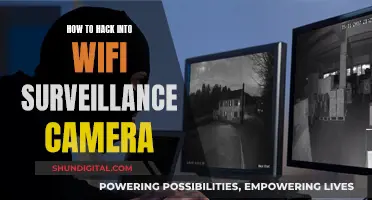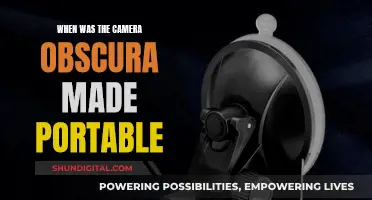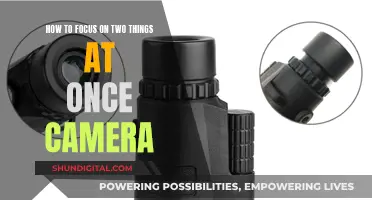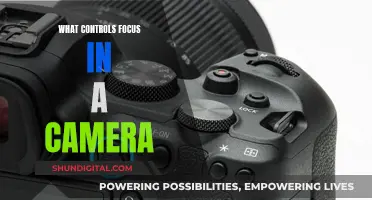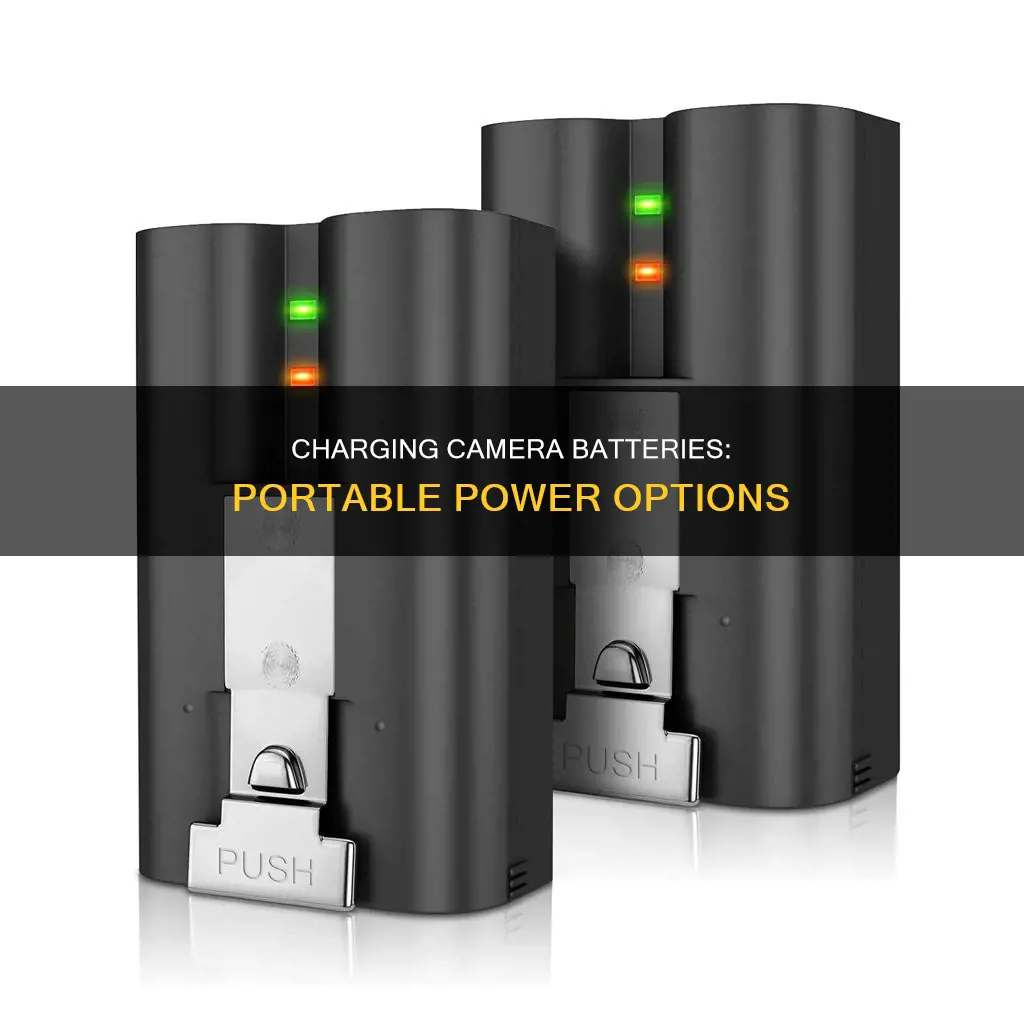
Keeping your camera battery charged while on the go can be a challenge, but there are several options available to you. One option is to use a USB charger, which can be more convenient when travelling than a standard AC battery charger. Most cameras, especially smaller ones like GoPros, can be charged using USB, either directly in the camera or with a separate charger. Another option is to use a power bank, such as the Pronto, which can charge a dead iPhone 5s in just five minutes. If you're travelling to a modern city, you may be able to simply plug your camera into a power outlet, but be sure to check the voltage and hertz of both the outlet and your charger to ensure they're compatible.
| Characteristics | Values |
|---|---|
| Charging method | USB, AC power, power bank |
| USB cable use | Insert the battery into the camera, connect the smaller plug of the USB cable to the camera, and the larger plug to a power source (power adapter or computer) |
| Power sources | Power adapter, computer, power bank |
| Power bank type | Pronto 5 and Pronto 12 |
| Power bank capacity | 4500mAh and 13500mAh |
| Power bank price | $80 and $120 |
| Power bank output | 12-volt output option |
| Charging time | Approximately 3 hours |
| Charging duration | Avoid charging continuously for more than 24 hours |
What You'll Learn

Using a USB cable to charge your camera battery
Charging your camera battery on the go with a USB cable is possible, but it depends on the type of camera you have. Some camera batteries need an additional USB charging converter, while others can be charged via a built-in USB connector. Before attempting to charge your camera battery with a USB cable, it is important to consult your camera's handbook or specifications to determine if it supports USB charging and what kind of cable or adapter is needed.
- Ensure that you have the correct USB cable and adapter. Some cameras may require a specific type of cable or adapter, such as the Canon IFC-600PCU cable.
- Insert the battery into the camera for charging. Make sure the battery is facing the correct way and locks into place securely.
- Connect the smaller plug of the USB cable to the camera terminal. The camera should be turned off during charging.
- Plug the larger plug of the USB cable into a power source. This can be a power adapter or a computer's USB terminal.
- Turn on the power source and begin charging. The charging process may vary depending on the camera model and power source used.
It is important to note that not all USB ports provide sufficient power for charging camera batteries. USB ports that supply 5V/2A power are recommended for efficient charging. Additionally, charging times may vary, and it is generally recommended to avoid charging continuously for more than 24 hours to protect the battery and maintain optimal performance.
Charging Camera Batteries: A Quick Guide to Powering Up
You may want to see also

How to charge your camera battery on a plane
As a photographer, you will likely want to take your camera gear with you when travelling by plane. Here is a guide on how to charge your camera battery while on the go, specifically on an aeroplane.
Firstly, it is important to note that there are specific rules enforced by aviation authorities, such as the FAA or EASA, regarding camera batteries. These regulations are in place to ensure the safety of flights. Standard batteries such as AA, AAA, C, and D can be freely carried on board without restrictions. They can be kept in your carry-on luggage or checked baggage, but they must be protected from damage and protected from creating sparks or a dangerous evolution of heat.
Lithium-ion batteries, commonly found in camera equipment, are considered safe if they are installed inside the camera. However, the FAA recommends keeping devices with these batteries in your carry-on baggage. If packed in checked baggage, they should be turned off, protected from accidental activation, and packed to prevent damage. Spare lithium-ion batteries should be carried in carry-on baggage, as loose lithium batteries in the cargo hold can pose a fire hazard. The FAA has set specific limits for lithium-ion batteries on airplanes: a limit of 2 grams of lithium per battery for lithium metal batteries, and 100-watt hours per battery for lithium-ion batteries.
Now, to keep your camera battery charged on the plane, you have a few options. Many cameras come with an AC battery charger, but charging from a USB power source is often more convenient when travelling. There are USB chargers available for common camera models, although you may need to search for them. Smaller cameras, like GoPros, often come with USB chargers. For larger cameras, you may need to bring a dedicated AC charger, which can be bulky and inconvenient.
To save space and weight, you can opt for a third-party USB charger, which is often smaller and can charge multiple batteries at once. However, these chargers are not endorsed by camera manufacturers and come with potential risks. Lithium batteries charged incorrectly can melt or catch fire, and there may be reliability issues with the chargers themselves.
To use a USB charger, you will need a power source such as a laptop, an AC adapter, or an external battery pack. This allows you to charge your camera batteries on long-haul flights, even if there are no AC outlets available.
Remember to always check the latest regulations and guidelines from organisations like the FAA, TSA, EASA, and IATA, as well as your specific airline, to ensure you are complying with any restrictions on battery types, quantities, and capacities.
Charging the Kimuvin Spy Pen Camera: A Step-by-Step Guide
You may want to see also

Using a power bank to charge your camera battery
First, make sure you have the right power bank. Look for one that has the USB-C Power Delivery feature, like the Anker power bank. This feature is essential to ensure your power bank can provide enough power to charge your camera.
Before you begin charging, determine how much power you need to charge your camera battery. Take out your rechargeable battery and find the specifications that list the mAhs (milliamperes) of energy your battery draws. This information will help you choose a suitable power bank. For example, if your camera battery requires 1,400 mAh, a 30,000 mAh power bank will be more than sufficient.
Now, let's get into the charging process:
- Install your camera battery: Place your camera battery securely inside your camera.
- Turn off the camera: This step is crucial as the battery may not charge if the camera is turned on.
- Connect your USB cable: Open the rubber cover on your camera that hides the cord connections. Connect one end of the USB cable to the power connection port on your camera.
- Attach the other end of the USB cable to your power bank: Ensure the cable is properly plugged into both the camera and the power bank.
- Monitor the charging process: Depending on your camera model, you may be able to observe the charging status through an LCD window or a battery icon. Additionally, some cameras have a light on the back that will blink red if the battery is low and turn solid green when it's charging.
- Allow sufficient charging time: It usually takes a couple of hours for the battery to charge fully. Once the battery is charged, the green light will turn off, and the battery icon will indicate a full charge.
It is important to note that some camera manufacturers do not recommend charging your camera battery directly from a power bank. Always refer to your camera's specifications and be aware of any potential risks before attempting this method. Additionally, ensure that your power bank has enough charge to power your camera.
Charging Your Campark: A Step-by-Step Guide
You may want to see also

Using a laptop to charge your camera battery
Charging your camera battery using a laptop can be a convenient option, especially when travelling. Here is a comprehensive guide on how to do it:
First, check your camera model to ensure it supports charging via a laptop. Refer to your camera's operating instructions or manual to confirm. Some camera models do not support charging through a laptop's USB port and require a dedicated charger.
If your camera is compatible, gather the necessary items: your camera, a laptop, and a USB cable compatible with your camera. It is essential to use the correct cable to ensure a proper connection and safe charging.
Once you have the required items, follow these steps:
- Turn off your camera. Charging will not occur if the camera is powered on, and you risk damaging the battery or device.
- Connect one end of the USB cable to the camera's input port, often located under a rubber cover.
- Connect the other end of the USB cable to one of the laptop's USB ports.
- Leave the camera connected until it is fully charged. The charging time may vary depending on your camera's battery capacity and the laptop's output power.
- Once charged, safely disconnect the USB cable from both the camera and the laptop.
It is important to note that charging a camera battery from a laptop may cause the laptop's battery level to decrease, especially if the laptop is not connected to a power source. Therefore, it is advisable not to leave the camera connected to the laptop for an extended period. Additionally, ensure that you do not turn on/off or restart the laptop, or wake it from sleep mode, while the camera is connected, as this may cause a malfunction.
When charging your camera battery using a laptop, always follow the safety precautions provided by your camera and laptop manufacturers. These precautions may include using the original or recommended cables, avoiding excessive heat or moisture, and properly storing the battery when not in use.
By following these steps and precautions, you can effectively charge your camera battery on the go using your laptop, ensuring you never miss a moment to capture that perfect shot.
Charging the A7 Camera: A Step-by-Step Guide
You may want to see also

Using a power strip to charge multiple devices, including your camera battery
When travelling, it's important to consider how you'll keep your camera battery charged. One option is to use a power strip, which can be especially useful when travelling to populated cities and towns. Power strips can charge multiple devices simultaneously, including your camera battery, and they are compatible with various devices, such as phones, tablets, e-readers, and laptops.
A power strip with USB ports is a great solution if you want to charge multiple devices at once. For example, the Insignia™ 2-Outlet/2-USB Power Strip features two USB ports and two AC outlets, allowing you to connect multiple devices at the same time. It also has a 6-foot fabric-wrapped cord for efficient cable routing.
If you need to charge more devices, consider the HITRENDS Surge Protector Power Strip, which features six outlets and six USB charging ports, allowing you to charge up to 12 devices simultaneously. This power strip also has a 6-foot heavy-duty extension cord and is made of fire-resistant material for added safety.
When choosing a power strip, consider the number and type of ports you need, the length of the cord, and whether you require any additional features such as surge protection or a compact design.
Beach Camera Sales Tax: What You Need to Know
You may want to see also
Frequently asked questions
There are several ways to charge your camera battery on the go. You can use a USB cable to charge your camera battery from a laptop or power bank, or you can use a dedicated portable charger like the Pronto, which is designed to charge camera batteries quickly.
The best way to charge your camera battery while travelling depends on your specific needs and camera model. If you want to charge your camera battery on the go, it is recommended to use a portable charger or power bank. If you are travelling to a location with access to power outlets, you can use a universal charger that supports a wide range of inputs and voltages.
Check the specifications of your camera battery charger to see if it supports a range of inputs and voltages. For example, a charger with an input range of 100-240V and 50/60Hz will work in most countries. If your charger is not universal, you may need to purchase a converter to use it in locations with different power outputs.



